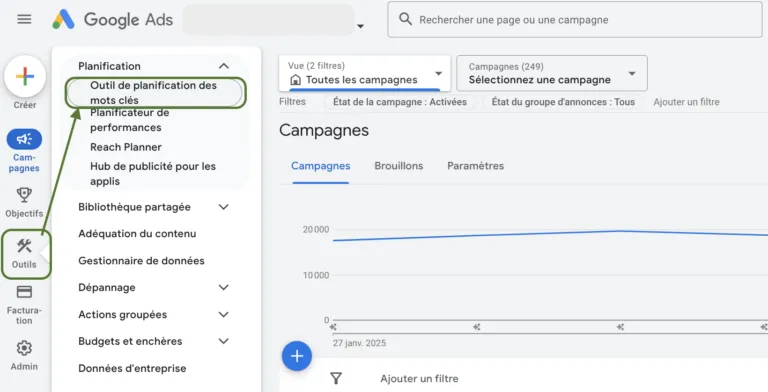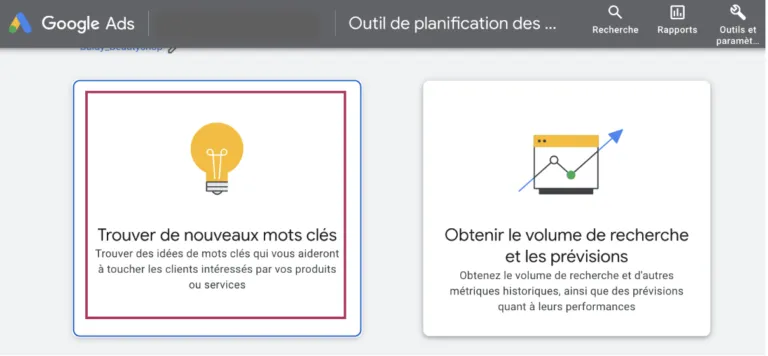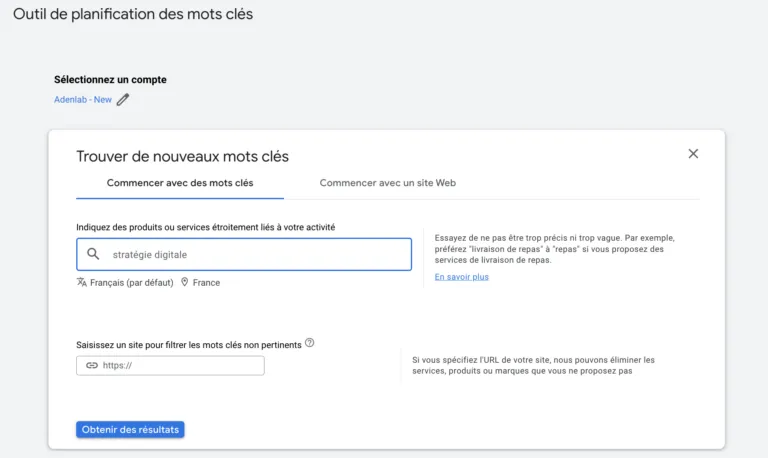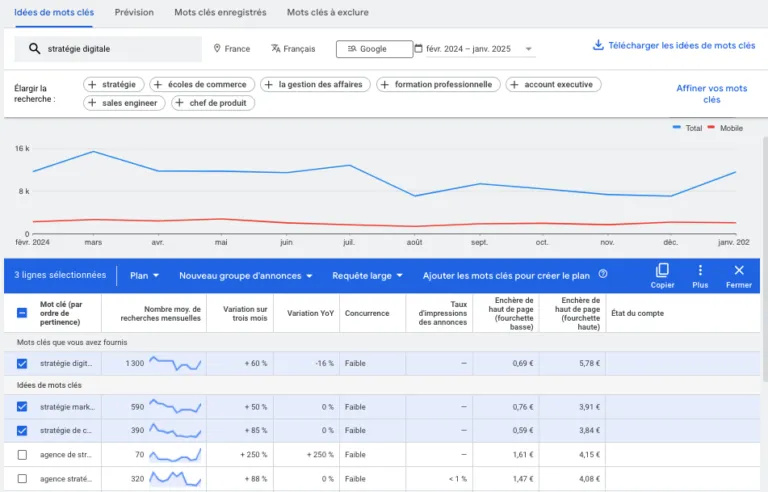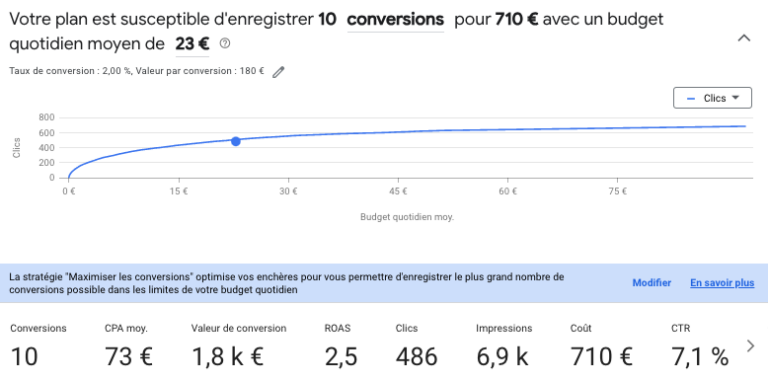Google’s Keyword Planner is an under-used tool in Google Ads campaign management. Using it properly will bring you many benefits. We’ll explain why.
It allows you to plan and optimize your advertising investments on Google Ads and increase the effectiveness of each of your ads and campaigns.
By using this free tool, you can fine-tune your Google Ads strategies (but also your SEO), ensuring that every euro spent is maximized.
This approach has a direct impact on the google ads price prices by providing a better understanding of search trends and audience behavior.
- The importance of planning in Google Ads.
- Influence on campaign cost and effectiveness.
- Optimizing advertising investments.
Understanding keyword planning in Google Ads
What are the main features of the planning tool?
Using the Keyword Planning tool in Google Ads is an important step in maximizing the impact of your campaigns.
This tool will enable you to discover the potential keywords and searches used by your future customers, estimate their cost and predict their impact on your campaigns.
With this tool, you can create lists of relevant keywords that match your target audience, taking into account past performance and future estimates.
NB: A good choice of keywords can significantly reduce the cost of google ads by optimizing return on investment.
Access and navigate the keyword planning tool
To access the planning tool, log in to your Google Ads account. In the tools tab, select “Keyword Planner”. This tool features an intuitive interface that allows users to easily navigate between different sections, such as keyword suggestions and traffic estimates.
Please note Efficient navigation of this tool requires a certain familiarity with its operation. Take the time to learn how to get the most out of it.
Regular use of the tool can be essential for optimizing your Google Ads campaigns. With the right use, you’ll be able to improve performance and reduce campaign costs.
Using the keyword planner effectively
Search and discover new keywords
Keyword research is the first step in using the planner. By entering terms related to your company or product, the tool suggests a list of relevant keywords. These suggestions are based on current search trends and historical performance data.
Good to know: Using English and French search terms can diversify your results and improve the reach of your campaigns.
Analyze and estimate the performance of identified keywords
Once the keywords have been identified, it’s crucial to analyze their potential performance. The planner provides estimates of search volume, cost per click and competition. This data enables advertisers to prioritize the most promising keywords for their campaign.
E.g.: Keyword selection
Budget simulation :
Leverage keyword-based optimization strategies
Once you’ve identified and analyzed your keywords, the next step is to integrate them into your campaigns.
This can include adjusting bids, creating specific ad groups, and improving ad quality to match search intent.
Effective use of the Keyword Planner can turn your Google Ads campaigns into real growth engines for your business.
Good planning can lead to significant savings and greater efficiency in your growth.
Optimizing Google Ads campaigns
Using keywords to optimize campaigns
Keywords are at the heart of any successful Google Ads campaign. Their selection and optimization can turn an ordinary campaign into a resounding success!
By identifying the most relevant and best-performing keywords, you can tailor your ads to better align with the search intentions of your target audience.
NB: Including quality keywords in your campaigns can considerably improve their effectiveness, even on a limited budget.
Focus on keyword quality rather than quantity
Adding a large number of keywords to your campaigns is not always the best approach.
It’s best to focus on high-quality keywords that are relevant and have a high potential for generating conversions. This will help you optimize your spend and improve ROI.
Customize keywords according to budget and objectives
Every company has different budgets and objectives. Personalizing your keywords according to these elements is crucial to maximizing the effectiveness of your campaigns.
This means choosing keywords that not only fit your budget, but also align with your business objectives.
By optimizing your Google Ads campaigns with relevant keywords, you can increase their effectiveness while keeping strict control over the budget.
Advanced strategies to maximize efficiency
Audience targeting for greater reach
Precise targeting of your audience is essential to maximize the impact of your campaigns. By using the opt-in and opt-out options available in Google Ads, you can target specific groups, enabling you to deliver your ads to the people most likely to be interested in your products or services.
Important: The right targeting can reduce the price of google ads by limiting unnecessary clicks and increasing conversions.
Bid estimation and advertising budget management
Estimating bids is a crucial step in managing your advertising budget.
By using the keyword planner, you can obtain data on the recommended bids for each keyword, helping you to define a realistic budget and adjust your bids accordingly.
Using Google Ads insights and recommendations to improve performance
The “insights” and “recommendations” pages in Google Ads are great resources for fine-tuning your campaigns.
They provide data and suggestions based on past performance, helping you to identify opportunities for improvement and adjust your strategies accordingly.
Adopting advanced strategies can improve the reach and effectiveness of your Google Ads campaigns, while optimizing the use of your budget.
FAQ
What is the keyword planning tool and why is it important?
The Google Ads keyword planning tool enables you to select the most relevant keywords for your advertising campaigns. It’s important for optimizing ad targeting and increasing their effectiveness, as well as for estimating your budgets.
How do I access the keyword planner in Google Ads?
To access the Keyword Planner, log into your Google Ads account, click on the tools tab, and select “Keyword Planner”. This tool is essential for discovering new keywords and estimating their potential impact.
What are the advantages of using this tool for small businesses?
The Keyword Planner offers a cost-effective way of optimizing your Google Ads campaigns. Using this tool, you can identify high-potential keywords, maximizing your return on investment even on a limited budget.
How do you choose the right keywords for a specific campaign?
The Keyword Planner offers a cost-effective way of optimizing your Google Ads campaigns. Using this tool, you can identify high-potential keywords, maximizing your return on investment even on a limited budget.
Conclusion
In conclusion, the keyword planning tool is an indispensable tool for optimizing Google Ads campaigns.
Not only does it reduce costs, it also increases ad effectiveness. By integrating this practice into the day-to-day management of your campaigns, you can anticipate your return on investment.
Need to evolve your digital strategy?
We carry out a complete diagnosis of your strategy and campaigns.
Fully supported by Adenlab, you pay nothing.
Our free preliminary audit will give you a clear picture of the current state of your campaigns. It will enable you to identify and plan the evolution of your performance on your acquisition channels.


